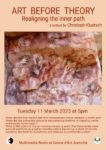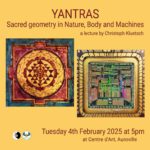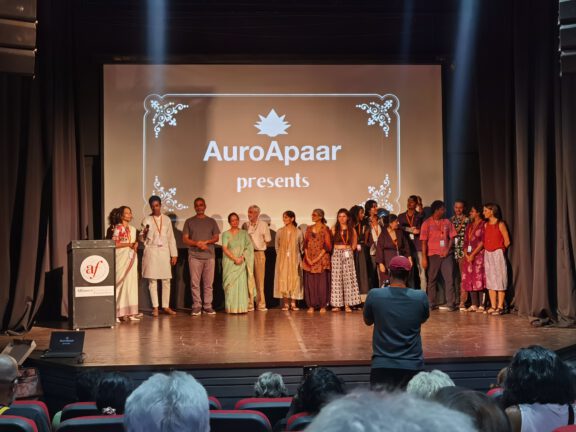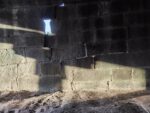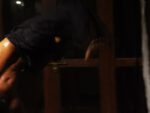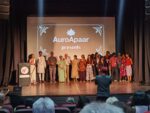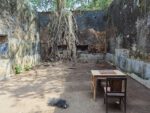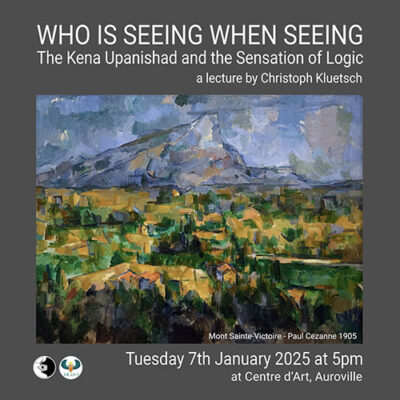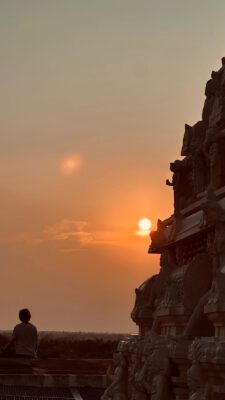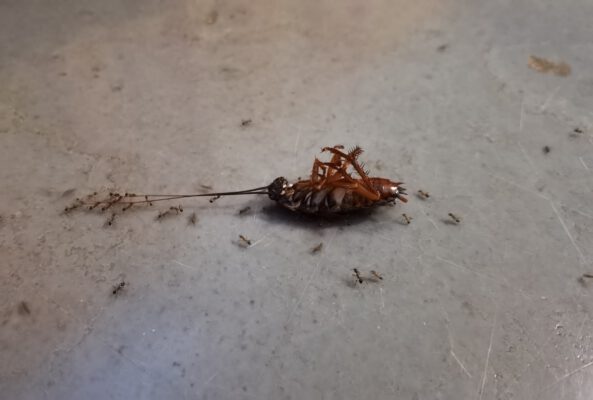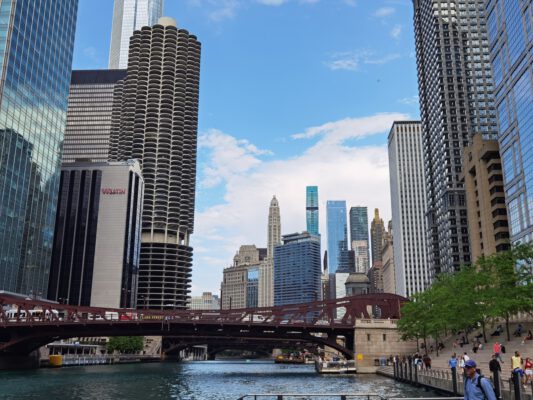Manifesto
Dance-film festival
28 Jul 2023 to 30 Jul 2023
https://auroapaar.org/festival/
What has actually manifested itself? The moving images that emerged from the latent images and are ‚brought to life‘ in their sequence of at least 24 frames per second, these images of dancers who, according to their genre, were already at the beginning of cinematography, these images showed up at the Dance-film Festival Manifest from 28 to 30 July 2023 at the Alliance Française in Pondicherry.
During the 2,5 days festival in the event space of the Alliance Française, 40 short films were shown. I actually just wanted to drop in and ’support‘ the first set of films, as I know they are often not well attended. I stayed 2,5 days and watched every film, every live performance and visited, as far as the program allowed, the master classes. I was electrified. I know such an intense art experience only from big biennials or media festivals.
I kept asking myself what was manifesting itself here. Various media theories came to mind: Dziga Vertov’s Kinoeye and the universal language of film, which is not bound to any language and enables the world to unite in the sense of a proletarian revolution. Or Godard’s famous quote that truth consists of 24 frames per second, and the media-critical theories derived from it that deal with fictionality, lies, and representation. And of course Gilles Deleuze and his homage to Henri Bergson’s theory of the cinematographer. Deleuze turns Bergson’s critique of film into a paean, understanding technical quality, film editing as active thought, pure philosophy. But all this, even the theory of the moving image, seemed to me not to grasp the phenomenon of this dance film festival.
A new genre?
Through their work, the organizers posed the question of whether a new genre was forming here. What is a genre? What is forming in what manifestation? Dance. An archaic form of expression that goes back to the animal kingdom, and at the same time one of the most complex, because it understands the whole body as a medium of expression. Dance is a movement of a body in space. The connection of body, space and time, interwoven through rhythm is perhaps one of the most complex and challenging forms of expression for a 2-dimensional, linear media like film. The predetermined camera perspective, the framing of the image, the technical structure of the apparatus, all work against dance. And so, for me, dance films have actually always been experimental or banal. Banal when it was simply a recording of a performance, experimental when, through editing and montage, individual segments of an otherwise continuous expression were expanded and contextualized, often ending in a rather cryptic sequence of movement intervals that was only accessible to insiders.
Perhaps I’ll start concretely, with the venue where all this takes place. An event space wonderfully suited as a cinema. A stage in front of it. The festival is in Pondicherry, a former French colony in India, this colorful subcontinent with countless languages and traditions. This multicultural subcontinent, rather arbitrarily united by a national border by the British in 1947, has chosen dance as one of its central, unifying cultural forms. There is a lot of dancing, at weddings and temple festivals, in Bollywood and at village fairs. Dance is omnipresent in many areas of society in India. It was all the more surprising to see that no major Indian productions were represented in the festival program. Dance was live on stage. That says a lot, but more on that later.
Rasa
The root of Indian aesthetics lies in the concept of rasa, often translated as taste, but not so much in the sense of a taste for art, but very specifically in the sense of the senses of taste. The activation of the inner senses, which gives a kind of quality to sensory impressions. The outwardly directed senses see, touch or hear ETWAS, direct themselves to ETWAS. The taste of sweet or sour is rather a quality ETWAS tastes sweet or sour, it has the quality of being sweet or sour. Corresponding to these properties is an inner sensual experience. This can be transmitted through the expressive power of theater, poetry, music and dance. In the Natya shastra, there are the four basic principles of love/eroticism (Śṛngāram), heroism (Vīram), anger (Raudram), and disgust (Bībhatsam). Someone loves, is a hero, is angry or disgusted. The whole becomes arbitrarily complex, the emotional qualities differentiate themselves, colors and costumes are assigned to them and gods correspond to their powers, and culminate in dance.
At this point, it is important for me to note that at the core of this aesthetic, which is still the basis of traditional dance in India, is the inner emotional state. This emotional state is embodied and manifested by the performers and evokes the same feeling in the viewer. This is basis of aesthetic theory in India.
It is opposed to the tradition of European aesthetics since Plato, with its focus on representation. This retinal conception of art, the idea that art takes place in the eye, gave rise to central perspective, the camera and the cinematographer.
Moving images
So what happens when the eye of the camera is focused on the dancers? How does a dancer’s expression transfer to the screen? What new narrative forms are opened up by editing and montage? In his 1935 essay „The Work of Art in the Age of Its Technical Reproducibility,“ Walter Benjamin saw the loss of aura through new media such as broadcasting and film as by no means only negative. Editing and montage freed the ‚performing‘ artists from the constraints of a theatrical space, and made it possible to visualize what could otherwise only be evoked in the imagination. To me, this historical starting point seems promising in the question of a new genre of dance film. Theater has been liberated by film in some respects; it has been almost completely replaced by movie theaters in the United States, for example. Significantly, Broadway theaters, musicals that is, which retain dance as one of their central principles, bucked this trend. They remain popular to this day. The experience of dance theater as a live experience has a high value in almost all cultures that have a stage culture. Even MTV’s music videos couldn’t change that much.
What became visible on Manifest is not a new phenomenon. But the focus of Manifest was deliberately on the fusion of film art and theater. Strategically, the decision to only allow films that consciously exploited the artistic expressiveness of the medium of film was the right one. In this way, something was concentrated and made visible. Perhaps in a new genre. It is something different than „Singing int the Rain“ or Wim Wenders documentary „Pina Bausch“, it is also not Michel Jackson’s MTV videos, or Bollywood’s „Dilwale Dulhania Le Jayenge“. One could say that the 40 films selected at the festival were short films that chose dance as their language. An international language without words, as Dziga Vertov called for, and a language that contrasts the core of moving images, which is the language of movement. While Bergson and Godard accuse the cinematographer of lying, and Deleuze identifies truth purely in the materialized form of thought in film, the dance film attempts the impossible, the squaring of the circle: focusing film on movement as language in 3-dimensional space. This restrictive focus is tantamount to a manifesto, just as the numerous art movements of the avant-garde have produced.
Space and screen
The Incubator Lab’s Hybrid Films experiments were exciting. Dance choreographies were implemented in the film and performed on stage. The main point was to feel the difference as an audience. What is the same and what is different? What works and what doesn’t? The productions were smaller experiments that invited reflection.
The festival catalog is available here: https://auroapaar.org/wp-content/uploads/2023/07/MANIFEST-2023-CATALOG.pdf.
It’s worth a look, I really liked the films on the following pages: 9, 10, 12, 14, 15, 16, 19, 25, 26, 29, 30, 32, 34, 35, 37, 41, 42, 56
Alliance Francasie Pondicherry


